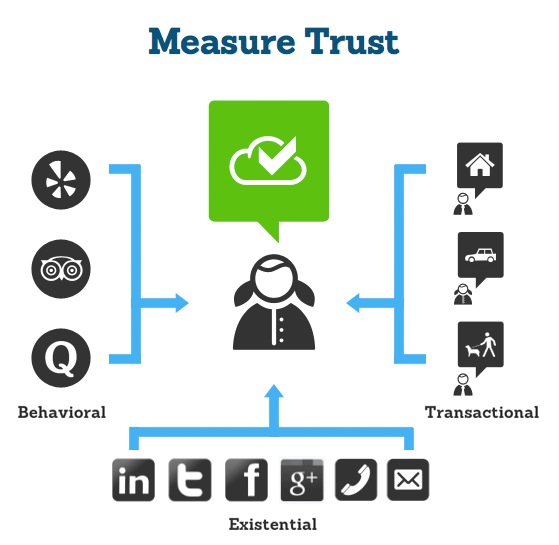What will your most valuable asset be in the near future? Not a physical object or your bank account, as collaborative consumption champion Rachel Botsman would have it. It’s your reputation, online and off. In an age where people are doing an increasing amount of business with strangers through sites like Airbnb, being able to tell in advance that strangers will deliver as promised is becoming increasingly important.
But how does reputation get established?
In her recent TED talk, “Trusting In Strangers,” Botsman envisions a real-time stream of who has transacted with you online represented in a visual pattern to indicate to your trustworthiness to strangers.
TrustCloud is just such a tool, and has a lot of company these days in an increasingly crowded field (Legit, Scaffold, Trust.cc, etc.) that measures trust in a variety of ways. Looking at TrustCloud's homepage, there’s a cluster of familiar social media icons and other symbols on the TrustCard depicted there. What do they signify? Regarding Facebook, they say, “Your behavior can indicate you’re connected, transparent, and social.” Email and phone can be verified, confirming you’re a real person.
As this recent Wall Street Journal article details, a TrustCloud score functions in the sharing economy like a FICO score works in the credit economy. It's a 1,000 point score that can be displayed on profiles and blogs that serves as a proxy for trustworthiness in a variety of peer to peer transactions. It gives an algorithmic picture of who you are, functioning as a lubricant for increasingly prevalent peer to peer transactions online and off. As TrustCloud puts it:
"We measure your virtuous online behaviors and transactions to build a portable TrustScore you can easily use within the Sharing Economy."
If this movement is to reach beyond the already predisposed and out into the cautious, go-with-the-crowd mainstream, something like this must itself become a trusted standard, easily adopted by those that aren’t already tech savvy.
How can this happen?
TrustCloud explains its path there, directly addressing what we all are likely thinking:
“Trust is difficult to quantify– we’ve all heard the saying ‘I know trust when I see it.’ These days, however, there’s enough data generated from online activity to detect actual patterns of trustworthy behavior.”
They break it down into three layers: verification, behavior, and transaction.
The verification layer includes email, physical address and SMS verification. The behavior layer looks at who you are across social networks in an interesting way: “Our proprietary algorithms look for behaviors like responsiveness, consistency and longevity. In combination, these gestures speak volumes to how you behave online.” They wisely add, “Note — we only work with your publicly-available data in these forums and never cross the privacy lines without your permission.” The transaction layer looks at your ratings on sites such as eBay, Trustcloud’s algorithms sifting out the gamed ratings.
With this, I think TrustCloud has all the ingredients to give people enough confidence to transact with strangers. Now it’s time to see how it gets out into the broader world, and if it becomes the go-to standard.
How do you gauge the trustworthiness of strangers? Do you think a score derived from an aggregation of online transactions would help? Please share in comments.









